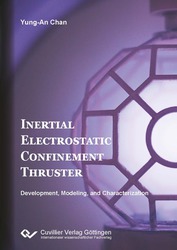| Areas | |
|---|---|
| Serie de libros (96) |
1378
|
| Nachhaltigkeit |
3
|
| Gesundheitswesen |
1
|
| Letra |
2364
|
| Ciencias Naturales |
5406
|
| Ciencias Ingeniería |
1792
|
| Ingeniería | 292 |
| Ingeniería mecánica y de proceso | 862 |
| Ingeniería eléctrica | 686 |
| Mineria y metalurgía | 30 |
| Arquitectura e ingeniería civil | 75 |
| General |
98
|
|
Leitlinien Unfallchirurgie
5. Auflage bestellen |
|
Erweiterte Suche
Inertial Electrostatic Confinement Thruster (IECT) (Tienda española)
Development, Modeling, and Characterization
Yung-An Chan (Autor)Previo
Lectura de prueba, PDF (800 KB)
Indice, PDF (120 KB)
This work summarizes the state-of-the-art development of inertial electrostatic confinement (IEC) thruster, which can be divided into two parallel lines of development: the IEC plasma source and the corresponding electromagnetic nozzle (EMN). Both developing lines start from the establishment of the theory and modeling and evolve to the design implementation and experimental verification.
The IEC discharge model highlights a novel perspective on the IEC discharge physics and the impacts of the respective critical parameters, which layouts the design for the IEC plasma source. Experimental verification for the theory is demonstrated via the optical emission spectroscopy and collision radiative model. The results provide conclusive evidence of forming a spherical double layer within the IEC plasma source, which is the key to establishing the proposed IEC discharge theory in this work.
This work presents a comprehensive study on the magnetohydrodynamic theory for assessing the plasma acceleration in the magnetic nozzle. Nevertheless, the result shows a performance limitation of the magnetic nozzle. An innovative invention is proposed to overcome the limitation known as the EMN. Thorough descriptions of EMN and its working principle are summarized in this work, including its effects on plasma confinement, acceleration, and detachment. Investigation of the plasma plume properties by miscellaneous plasma diagnostics tools further demonstrates EMN functionality and constitutes the first IECT prototype with proof-of-concept in literature.
| ISBN-13 (Impresion) | 9783736976771 |
| ISBN-13 (E-Book) | 9783736966772 |
| Formato | A5 |
| Idioma | Inglés |
| Numero de paginas | 272 |
| Laminacion de la cubierta | Brillante |
| Edicion | 1. |
| Lugar de publicacion | Göttingen |
| Lugar de la disertacion | Stuttgart |
| Fecha de publicacion | 19.09.2022 |
| Clasificacion simple | Tesis doctoral |
| Area |
Ciencias Ingeniería
|
| Palabras claves | 3D-printing electrode, collisional radiative model, double layer, electron beam, electron diamagnetic current, electron dynamics, electron energy distribution function, electron multiplication, electric potential topography, electric propulsion, electromagnetic nozzle, Faraday probe, hollow cathode discharge, inertial electrostatic confinement, Langmuir probe, magnetic nozzle, magnetohydrodynamics, narrow spectral-bandwidth imaging, non-neutral plasma, optical emission spectroscopy, plasma acceleration, plasma confinement, plasma detachment, plasma diagnostics, plasma discharge, plasma extraction, plasma source, space propulsion, spherical double layer, truncated cuboctahedron, CRM, EEDF, EMN, EP, IEC, MHD, MN, NBWI, OES, SDL,3D gedruckte Elektrode, Stoß-Strahlungsmodelle, Doppelschicht, Elektronenstrahl, diamagnetischer Elektronenstrom, Elektronendynamik, Elektronenenergieverteilungsfunktion, Elektronenvervielfachung, Topographie des elektrischen Potentials, elektrischer Antrieb, elektromagnetische Düse, Faraday-Sonde, Hohlkathodenentladung, elektrostatischer Trägheitseinschluss, Langmuir-Sonde, magnetische Düse, Magnetohydrodynamik, Bildgebung mit schmaler spektraler Bandbreite, nicht-neutrales Plasma, optische Emissionsspektroskopie, Plasmabeschleunigung, Plasmabeschränkung, Plasma-Abtrennung, Plasmadiagnostik, Plasmaentladung, Plasmaextraktion, Plasmaquelle, Raumfahrtantrieb, sphärische Doppelschicht, abgestumpftes Kuboktaeder, SSM, EMD, EA, MD, BSSB |








